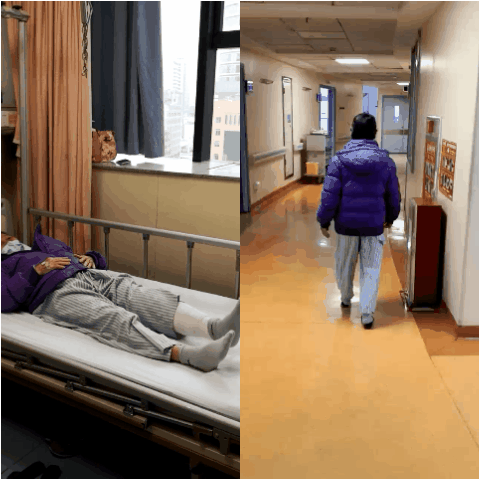With the increase of age, the water, cartilage cells and part of the protein in the articular cartilage are lost, the cartilage health and nutritional function of the joints are lost, and the load capacity of the cartilage is weakened and then lost, which accelerates the wear of the knee joint .
The 76-year-old mother-in-law Lu suffered from the wear and tear of the right knee joint two years ago, and it hurts when she walks. It was found that although there was pain from time to time, it was still in a relatively mild stage and could be treated conservatively by regular injection of sodium hyaluronate.
Many friends of the same age around Granny Lu have knee joint problems to some extent. She also heard that some people even had their knee joints replaced. She experienced all kinds of pain during the operation, which made her feel uneasy about the operation. Also full of fear. After regular follow-up and treatment, Granny Lu’s symptoms were relieved. In order to protect the “injured” knee joint on this side, Granny Lu habitually focused on her left leg, for fear of increasing the burden on her right leg.
“Later, her right leg didn’t hurt so much, but the old man climbed up and down the stairs several times a day, rode a bicycle for exercise, and used almost all his strength on the left leg.” Granny Lu’s daughter said, Until recently, the elderly suffered from sudden acute pain and could not walk normally.
Just after the Lunar New Year, Granny Lu, accompanied by her family, came to Director Lu Weijie’s clinic again, “Due to prolonged and continuous exertion, the cartilage in the medial compartment of the left knee joint was severely damaged, and the joint space was severely damaged. Obviously narrowed.” Director Lu Weijie gave her a detailed examination and was diagnosed with anteromedial end-stage knee osteoarthritis. Currently, only knee replacement surgery can improve the symptoms.
Knee replacement
Knee replacement includes total knee replacement and unicondylar replacement.
Total knee arthroplasty is mainly suitable for patients with multiple knee compartment wear and severe deformity, but the incision is relatively large, the muscles will also be damaged, and the ligament must be released.
Unicondylar knee resurfacing is suitable for patients with anteromedial condyle osteoarthritis and complete cartilage thickness in the lateral compartment. It has less damage, less bleeding, no muscle damage, and no ligament release. A joint replacement procedure that does not damage the muscles or strip the ligaments is also commonly referred to as a minimally invasive joint replacement.
When she learned that she was going to replace her joints, Granny Lu was worried at first. How painful is such a big surgical wound? Will I have to stay in bed for a few months after surgery? Can the joints be replaced by artificial ones as well as their own? …
The doctor patiently answered these questions from Granny Lu, especially for the “pain” problem that many elderly people are very concerned about, “Our team has integrated the concept of rapid recovery into the entire surrounding The whole-process management during the operation period, combined with a variety of pain relief methods, adopts the most minimally invasive surgical plan, reduces the discomfort of the patient as much as possible, and achieves rapid postoperative recovery.” Director Lu Weijie said, in order to make Granny Lu have a better life The “sense of experience” made her an individualized surgical plan – a knee joint unicondylar replacement with small incision, less trauma, and less impact on the whole body.
During the operation, the Department of Combined Anesthesiology and Surgery adopted the perioperative analgesia method of adductor canal block, which adopted postoperative analgesia by adductor canal block and catheter placement under the guidance of B-ultrasound. By making the analgesic and anesthetic drugs act directly on the saphenous nerve, combined with multi-modal analgesia methods such as “cocktail”, the surgical wound has almost no pain, and the adverse reactions of the drugs are reduced.

On the first day after the operation, Mrs. Lu was able to walk down the ground and the leg on the operated side could be lifted up smoothly. , straightening, bending, and quick recovery after surgery. Grandma Lu said excitedly: “I didn’t feel any pain on the day after the operation. If I hadn’t been in the water and had some equipment on, I would have been able to get out of bed at that time.” Granny Lu and her family were very satisfied with the results of the operation and praised the medical team again and again.
Instructor

Weijie Lu
MD, Chief Physician of Orthopedics< /p>
The First Affiliated Hospital of Guangzhou Medical University
Director of Major Surgery, Director of Surgery Teaching and Research Office, Director of Orthopedics, Director of Joint Surgery, Director of Editorial Department of “Chinese Journal of Joint Surgery (Electronic Edition)”
p>
Specialties: Joint surgery (especially good at artificial hip, knee replacement and revision surgery), limb joint fractures, bone disease and bone tumor, surgical treatment of osteoporosis. Indications: Osteoarthritis, congenital dislocation of the hip, dysplasia of the hip, avascular necrosis of the femoral head, rheumatoid arthritis, congenital coxa varus, gluteal muscle contracture, snapping hip, joint tuberculosis and suppurative Arthritis, pigmented villonodular synovitis, joint bone hyperplasia, ankylosing spondylitis involving hip and knee joints, limbs and joint fractures and bone tumors, tumor-like lesions, osteoporosis, etc.
Visit time (Yangjiang Campus): Monday morning, Wednesday afternoon

Correspondent: Surgery Lin Minying
Editor: He An
Editor: Aru